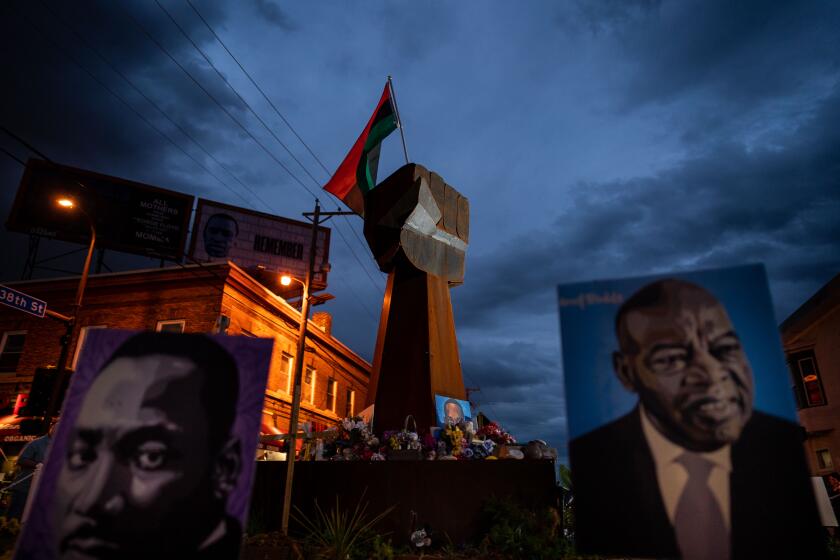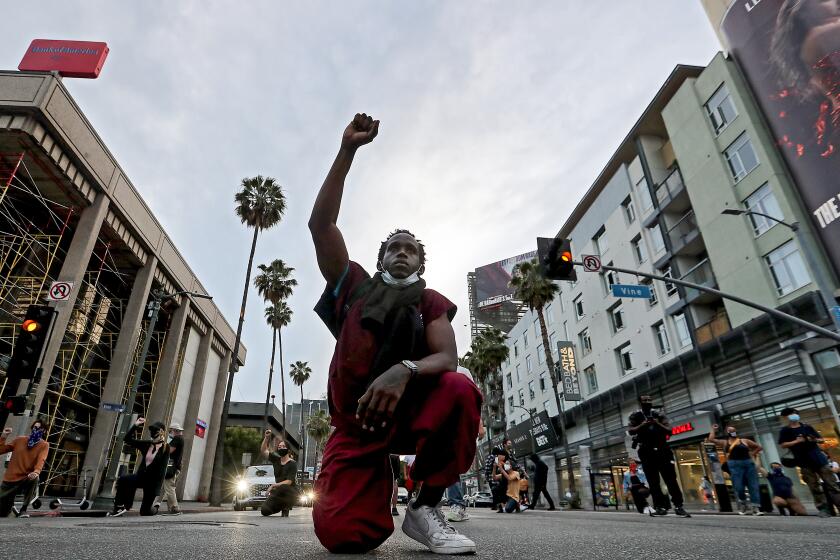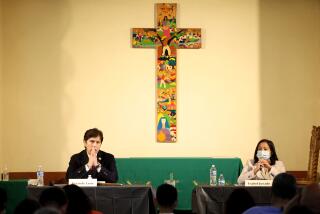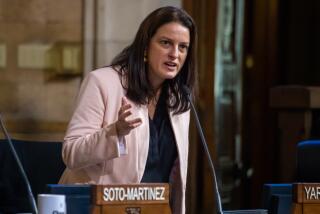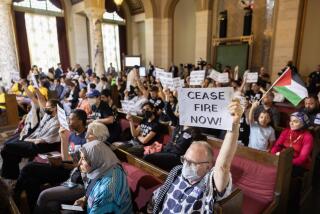L.A. cut millions from the LAPD after George Floyd. Here’s where that money is going
One year after George Floyd’s murder in Minneapolis, Los Angeles city leaders on Tuesday finalized their plan for spending money that was moved last summer out of the police department and into programs aimed at helping communities of color.
The vote by the City Council means some $89 million originally slated to pay for police services will instead flow to antigang initiatives, universal income programs, homeless services, education and jobs initiatives and more.
The council’s action followed a drumbeat of calls from activists and community groups who sought a rethinking of the city’s budget following a tumultuous year of protests over police brutality and a health crisis that laid bare the inequality that plagues the city.
Although activists expressed satisfaction in seeing law enforcement funding go into social programs, some remained frustrated that Mayor Eric Garcetti and the City Council recently increased the LAPD’s budget for the fiscal year that starts on July 1.
Councilman Curren Price, who is running for reelection in 2022, called the reprogramming of the LAPD funds part of a “continuing down payment in our quest for equity and reimagining public safety.”
“The world is waiting and our citizens are waiting and watching,” said Price, who represents neighborhoods in downtown and South L.A., at Tuesday’s meeting. “We still have a lot to do before we can truly celebrate.”
The council’s cut to the LAPD was one in a series of actions taken by city leaders in response to last year’s protests. The city also began exploring ways of moving key assignments out of the LAPD and into the hands of unarmed civilian city workers.
George Floyd’s killing at the hands of police transformed lives around the world, but nowhere as profoundly as in the city where it occurred.
The deliberations over how to reprogram the LAPD money consumed nearly 11 months at City Hall, drawing a rare veto from Garcetti and an equally rare veto override from council members.
Whether the city will have the money to sustain the programs approved Tuesday is still an open question. At the same time, an increase in shootings and homicides is putting new pressure on city leaders to balance activists’ push to cut LAPD spending with demands from constituents to improve public safety.
The City Council cut the LAPD by $150 million in July, after massive protests following Floyd’s death, pledging to put the proceeds into disenfranchised communities. Council members quickly set aside $60 million, using much of those funds to balance the budget, leaving about $89 million for various programs.
The council unveiled an initial list of spending priorities that including youth and recreation programs, neighborhood beautification initiatives, and job and business programs.
However, the proposals were criticized by the Los Angeles Police Protective League, the union representing rank and file police officers, for including nuts-and-bolts services, such as tree stump removals and landscaped medians. Garcetti vetoed the initial proposal and urged the council to instead spend money on racial justice, income inequality and community safety programs.
The council reacted to Garcetti’s veto by overriding it and allocating $32 million toward policing alternatives, including community intervention officers, as well as homeless prevention and homeless services.
Tuesday’s vote dealt largely with how to spend the remaining $56 million, as well as some adjustments to the earlier spending plan.
In some council districts, the proposals approved Tuesday are extremely specific.
Councilman Gil Cedillo, who represents Eastside neighborhoods, put $2 million toward the repair of high school athletic fields in Lincoln Heights, $3.5 million for job training and gang intervention programs and additional funding to improve streets and parks.
Other council members left the details to be worked out later. Councilman Joe Buscaino, whose district stretches from Watts to San Pedro, allocated about $3 million for public safety alternatives in Watts, Wilmington and San Pedro, but it’s unclear how those funds will be spent.
Other money reprogrammed from the LAPD will go toward creating a COVID-19 bereavement fund, domestic violence support, tenant advocacy programs, arts initiatives, street lights, beautification programs, new trash cans and cameras aimed at catching people who engage in illegal dumping.
The board of directors of the Los Angeles Police Protective League issued a statement after Tuesday’s vote that was mostly positive about the final spending plan.
“The current list of funded projects, although not completely devoid of unproven programs, is a stark improvement over the initial list announced last year that consisted of curb cuts, tree trimming and other political pet projects,” the union statement said. “The council should continue to focus on reinvesting in public safety and ensuring our department is adequately staffed.”
At a committee meeting last week on the spending proposals, Ricci Sergienko, an organizer with the People’s City Council, an umbrella group representing several activist groups, criticized a $100,000 allocation for an LAPD-backed youth program in Councilman John Lee’s San Fernando Valley district. But he offered praise, too.
“Look at all the good things that you know we can fund when we divest from the police,” Sergienko said.
Activists signaled Tuesday that they would continue to pressure politicians to shift spending away from the Police Department.
As council members convened inside City Hall, a crowd of about 100 led by Black Lives Matter-Los Angeles and other groups stood in the street outside chanting, “Defund the police.”
“We must demand to defund the police, in the streets, in city council meetings, in police commission,” said Tyler Boudreaux, an activist with Black Lives Matter-L.A. “We must demand it in our networks, keep talking about it with family and friends and make it simple: defund the police and invest in our communities.”
Several activists expressed disappointment that council members unanimously voted last week to increase the LAPD’s operating budget by 3% in the upcoming fiscal year.
The murder of George Floyd a year ago sparked protests nationwide. Angelenos gathered Tuesday to commemorate his life.
At Tuesday’s rally, Boudreaux called on Councilman Paul Krekorian to take up a proposal to scale back next year’s deployment by roughly 250 police officers. The proposal, backed by council members Mike Bonin and Nithya Raman, would keep LAPD sworn staffing at 9,450 police officers during the coming budget year.
Before last year’s protests over Floyd’s death, deployment at the LAPD was 10,009 officers, according to a report issued to council members in June. The council declined to take up the Bonin-Raman proposal last week, referring it to Krekorian’s committee.
Activists also unveiled the results of a survey conducted in recent weeks from the People’s Budget L.A., a coalition of groups headed up by Black Lives Matter L.A. Those who took part want a 77% decrease in LAPD funding and a nearly 35% cut in funding for the city attorney’s office.
“We’re not talking about reform,” said Akili, an organizer with Black Lives Matter-Los Angeles, at Tuesday’s rally. “We’re talking about defund. We’re not talking about tinkering around the edges.”
City Council President Nury Martinez, asked about the city budget last week, said council members had conducted their own community listening sessions to gauge their constituents’ spending priorities.
Although council members received requests for more community resources, the kind approved as part of Tuesday’s vote, they also heard from communities that support spending at the LAPD, Martinez said.
In the east San Fernando Valley, some communities “do want additional police officers. They feel safer that way,” she said. “Some other communities don’t.”
More to Read
Sign up for Essential California
The most important California stories and recommendations in your inbox every morning.
You may occasionally receive promotional content from the Los Angeles Times.
